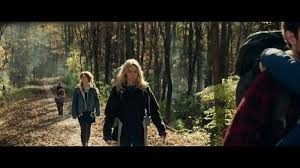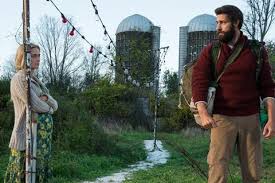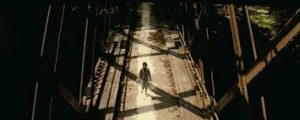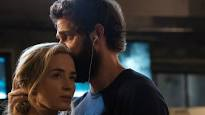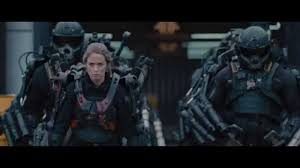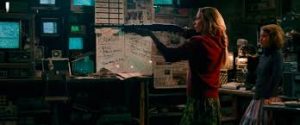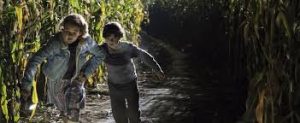SHORT TAKE:
Enjoyable, but immediately forgettable, popcorn Jaws near-parody which could have been and, given the improved technology, SHOULD have been better.
WHO SHOULD GO:
Mid-teens and up for language and violence, though there was not a lot of graphic gore. While a few audience members brought their younger kids, I would not have wanted the "nightmare" duty later.
AND IF YOU LIKE THESE REVIEWS PLEASE SUBSCRIBE! THEN YOU'LL GET EVERY NEW REVIEW SENT STRAIGHT TO YOUR E-MAIL!!
GO TO THE BOTTOM OF THE LEFT HAND SIDE AND TYPE YOUR E-MAIL IN – IT (SHOULD BE) THAT EASY. ANY PROBLEMS PLEASE SEND ME A COMMENT AND I'LL DO MY BEST TO RESOLVE YOUR ISSUE.
LONG TAKE:
When I was 16, my brother-in-law joined the military. After his signing in, he, my sister and I all went to celebrate by going to see Jaws, which had just opened at the downtown theater.  After the end of the very memorable opening scene, my brother-in-law, a dentist and one of the calmest people I have ever met, stood up and with his usual dry wit straight-faced announced: "O.K. I'm ready to go." He was only half serious and we stayed to watch the rest of this classic.
After the end of the very memorable opening scene, my brother-in-law, a dentist and one of the calmest people I have ever met, stood up and with his usual dry wit straight-faced announced: "O.K. I'm ready to go." He was only half serious and we stayed to watch the rest of this classic.
Although it has kept me well away from the idea of scuba diving for the last 40+ years, I have been hooked, so to speak on Jaws and other disaster-type movies ever since – be they good, bad or indifferent
So, I think I can say with some credibility, the Meg is Jaws Lite. While it has the virtues of a certain parody-like charm, it neglects, with apparent obliviousness, a couple of important features required of a really good monster movie.
SPOILERS!!!!!!!!!
It's not all bad. The Meg is based on a series of five books with the same base name, all researched and written by Steve Alten. At the publication of this review I am part way through the first one and it is fairly engrossing and provides some interesting background.
On the plus side, The Meg has, in abundance, one of the features important in most disaster movies in general, and specifically in the sub genre of monster movies – a sense of humor and/or self-awareness. Examples of where this works is in the quippy lines in Aliens (watching their only escape ship burn, "Maybe we can build a fire, sing a couple of songs, huh? Why don't we try that?") or  the entirety of Shaun of the Dead.
the entirety of Shaun of the Dead.  The director of The Meg, Jon Turteltaub, had the Meg's tongue planted firmly in cheek, (though, technically, almost no shark actually USES its tongue – called a basihyal. ed).
The director of The Meg, Jon Turteltaub, had the Meg's tongue planted firmly in cheek, (though, technically, almost no shark actually USES its tongue – called a basihyal. ed). 
 And how can it not evoke a few chuckles with Rainn Wilson as one of the major players? A veteran of such notables as The Office,
And how can it not evoke a few chuckles with Rainn Wilson as one of the major players? A veteran of such notables as The Office,  Galaxy Quest and as the "new" Harry Mudd in Star Trek: Discovery, Wilson has carved a niche out as one of the princes of dead pan egocentric humor, like Sam Rockwell and Jim Carrey.
Galaxy Quest and as the "new" Harry Mudd in Star Trek: Discovery, Wilson has carved a niche out as one of the princes of dead pan egocentric humor, like Sam Rockwell and Jim Carrey.
In addition, there is a small flavoring of homages to the Meg's predecessors. For example, Statham's character quotes  Martin Brody from Jaws to "chew on this" and he even references Finding Nemo. There are a few well deserved and needed grins earned throughout the movie. So to its credit, The Meg does NOT take itself overly seriously.
Martin Brody from Jaws to "chew on this" and he even references Finding Nemo. There are a few well deserved and needed grins earned throughout the movie. So to its credit, The Meg does NOT take itself overly seriously.
That's a good thing, because, everything else about the movie does not fare so well.
The premise is a string of glued together cliches:  Jason Statham (Furious movie franchise) is Jonas, and no traction is made of his name, which in nautical circles would refer to Jonah – from the Bible – someone considered unlucky to have on a ship. Jonas is a discredited deep sea rescue diver who saw a monster (the Meg) during a mission which everyone attributed to deep diving delusions and panic. He is brought back to his old job when a monster, such as he described, is found and he has to rescue some people. Of course, the fact he has been boozing it up and out of practice for the last 5 years has had no effect on his abilities or physique whatsoever. His ex-wife is in danger. He meets a new cute scientist with an
Jason Statham (Furious movie franchise) is Jonas, and no traction is made of his name, which in nautical circles would refer to Jonah – from the Bible – someone considered unlucky to have on a ship. Jonas is a discredited deep sea rescue diver who saw a monster (the Meg) during a mission which everyone attributed to deep diving delusions and panic. He is brought back to his old job when a monster, such as he described, is found and he has to rescue some people. Of course, the fact he has been boozing it up and out of practice for the last 5 years has had no effect on his abilities or physique whatsoever. His ex-wife is in danger. He meets a new cute scientist with an  even cuter child (Shuya Sophia Cai), who immediately takes to him. Someone heroically sacrifices himself to save his friends. Random people are devoured after citing Sedgwickisms (after General Sedgwick who was killed by a sharpshooter during the Battle of Spottsylvania Court House right after saying "They couldn't hit an elephant at this distance.") A greedy CEO (along with the military, CEO's are one of the go-to scapegoats of the lazy liberal screenwriter) abandons people in danger to prevent having to meet financial liability exposure. A kid paddles out into a crowded beach surf just as the Meg decides to smorgasbord the shallows under the watchful eye of his mother (ala Jaws but with a happier ending).There's even
even cuter child (Shuya Sophia Cai), who immediately takes to him. Someone heroically sacrifices himself to save his friends. Random people are devoured after citing Sedgwickisms (after General Sedgwick who was killed by a sharpshooter during the Battle of Spottsylvania Court House right after saying "They couldn't hit an elephant at this distance.") A greedy CEO (along with the military, CEO's are one of the go-to scapegoats of the lazy liberal screenwriter) abandons people in danger to prevent having to meet financial liability exposure. A kid paddles out into a crowded beach surf just as the Meg decides to smorgasbord the shallows under the watchful eye of his mother (ala Jaws but with a happier ending).There's even  an adorable dog, who you know won't be eaten, who jumps into the mix, or rather literally, the water. There is little or nothing new that The Meg contributes to the genre, though it pays decent respect to its brethren films.
an adorable dog, who you know won't be eaten, who jumps into the mix, or rather literally, the water. There is little or nothing new that The Meg contributes to the genre, though it pays decent respect to its brethren films.
The Meg's most serious problem is with its rhythm and structure. Specifically, it lacks two essentials for a scary movie: a sense of urgency and intimacy which can be summed up as: trapped in a ticking time bomb. In Jaws,  Brody, Hooper and Quint, who you come to care about,
Brody, Hooper and Quint, who you come to care about,  were all stuck out in the ocean, on a sinking boat, being stalked by a monster white shark.
were all stuck out in the ocean, on a sinking boat, being stalked by a monster white shark. 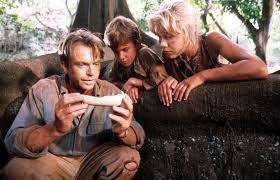 In Jurassic Park, Alan Grant and his plucky band of survivors were stuck on an island, while being chased by dinosaurs.
In Jurassic Park, Alan Grant and his plucky band of survivors were stuck on an island, while being chased by dinosaurs.  In The Towering Inferno, people were trapped in a high-rise above a fire line.
In The Towering Inferno, people were trapped in a high-rise above a fire line.  In The Poseidon Adventure
In The Poseidon Adventure 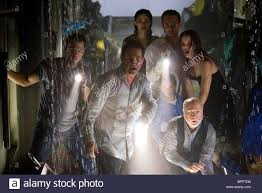 (both versions) the ensemble spent the entire movie trying to escape an overturned and sinking cruise ship.
(both versions) the ensemble spent the entire movie trying to escape an overturned and sinking cruise ship.  The Core had a bunch of scientists stuck miles underground trying to re-spin the Earth's core before all life on the surface was vaporized. You see the pattern. But in The Meg, although people are trapped briefly different places, for most of the film the cast can come and go as they like on
The Core had a bunch of scientists stuck miles underground trying to re-spin the Earth's core before all life on the surface was vaporized. You see the pattern. But in The Meg, although people are trapped briefly different places, for most of the film the cast can come and go as they like on  boats and in
boats and in  helicopters. There is no sense of a confined space from which emergence would mean victory
helicopters. There is no sense of a confined space from which emergence would mean victory
In spectacularly successful monster movies, there is a cast who we get to know and with whom we empathize, and while there is often a bad guy involved, such as  Paul Riser's corporate weasel in Aliens or
Paul Riser's corporate weasel in Aliens or  Murray Hamilton's self-serving mayor in Jaws, and
Murray Hamilton's self-serving mayor in Jaws, and  really great challenges, the primary antagonist is often … time. Something must be done before time Runs Out. And to heighten the sense of urgency, the scenario, as I mentioned above, is usually played out in a confined space from which our intrepid heroes must escape.
really great challenges, the primary antagonist is often … time. Something must be done before time Runs Out. And to heighten the sense of urgency, the scenario, as I mentioned above, is usually played out in a confined space from which our intrepid heroes must escape.
In The Meg, the time factor is played with and sprinkled around like random lampreys on a shark, but it is not THE shark. For example, Jonas' wife,  Lori (Jessica McNamee) and
Lori (Jessica McNamee) and  her crew, are stuck in a bathyscope, running out of air and stalked by the monster. But this is resolved within the first half-hour of the movie. Later,
her crew, are stuck in a bathyscope, running out of air and stalked by the monster. But this is resolved within the first half-hour of the movie. Later,  the scientists have to race the Meg to a crowded beach, but none of the people are characters we know, so we don't really care that much. The people in danger are more like NPCs, or non-player characters in a video game, which are only there to populate the scene, but in which we have no investment.
the scientists have to race the Meg to a crowded beach, but none of the people are characters we know, so we don't really care that much. The people in danger are more like NPCs, or non-player characters in a video game, which are only there to populate the scene, but in which we have no investment.
There is no structural time critical deadline which defines the arc of the movie, as there was in the  sinking Titanic or the burning Towering Inferno or the Jurassic-Dino-Park-Hunted-Alan-Grant party.
sinking Titanic or the burning Towering Inferno or the Jurassic-Dino-Park-Hunted-Alan-Grant party.
The lack of a temporal framework, the want of an urgent deadline, deflated much of what would have injected a sense of mortally important immediacy into the movie.
And it doesn't help that the suspense is undermined with the trailers. 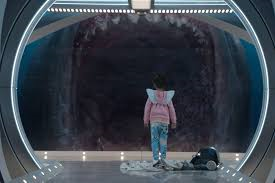 Not only did they give away the most spectacular visual – the shark bite in the window of the underground bio habitat in front of the little girl,
Not only did they give away the most spectacular visual – the shark bite in the window of the underground bio habitat in front of the little girl, 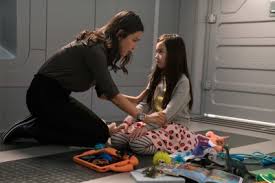 but showing the mom during that scene completely eliminates any tension in the
but showing the mom during that scene completely eliminates any tension in the  opening shots where she is put in danger by a prehistoric squid. We KNOW she is not in any danger with the squid because she shows up in the Meg-bite scene later in the movie.
opening shots where she is put in danger by a prehistoric squid. We KNOW she is not in any danger with the squid because she shows up in the Meg-bite scene later in the movie.
In addition there are plot holes. The most egregious is in the premise. The big issue that drives most of the movie is the entry of the Meg from a protected sub ocean into our part of the world. The implication is that this has never happened and would not have happened had the subs not gone to investigate creating a gateway through the cold gas layer acting as a barrier between the Meg world and our own.  However, Jonas was fired and in "exile" BECAUSE he claimed he had seen the results of one of these creatures on a ship during a deep ocean rescue FIVE YEARS before. How did it get out BEFORE the deep sea rescue?
However, Jonas was fired and in "exile" BECAUSE he claimed he had seen the results of one of these creatures on a ship during a deep ocean rescue FIVE YEARS before. How did it get out BEFORE the deep sea rescue?
Granted this is a popcorn movie but I hate to see distracting holes in plots where a sentence or two could have closed them. For example, they could have mentioned that Jonas' previous mission had taken place near where the research scientists were investigating. Or they could have admitted the possibility these Megs had another entry way into our world. I mean they want a sequel anyway, right?
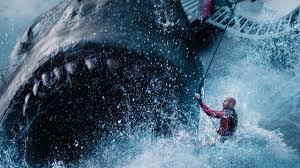 The Meg was neither more nor less than what I expected it to be. A fun, occasionally scary, popcorn movie. But, especially with the heightened CGI opportunities, it could have been so much more.
The Meg was neither more nor less than what I expected it to be. A fun, occasionally scary, popcorn movie. But, especially with the heightened CGI opportunities, it could have been so much more.
There is some youth inappropriate language (understandable as one is being stalked by a 70 foot shark, but still not for children's ears) and a lot of jump scares and violence. Though the majority of the human gore is left unseen in a flurry of action, things like a severed arm and terrified people being pushed and swallowed up by the Meg, again, make it unsuitable for all but mid to older teens and up, at a minimum.
But if you want an excuse to get your date to snuggle closer while she's hiding her eyes in your sleeve, then, by all means, go and have yourself a good shiver — but don't plan on any scuba trips in the near future.



